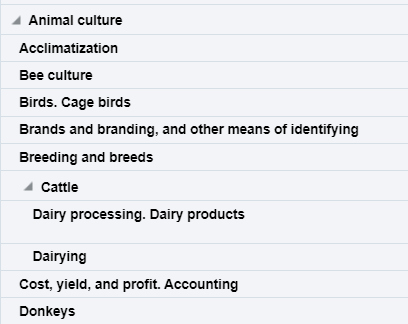LC Classifications
- Last updated
- Save as PDF
The Library of Congress Classification (LCC) is displayed in Analytics in the LC Classification shared dimension, available in several subject areas. LC classification information is derived from the bibliographic record in most subject areas, except for the Physical Items subject area, where it can be derived from either the holdings record or the bibliographic record.
- For MARC21
Taken from field 050$$a. If 050$a has no content, 090$a is used.
https://www.loc.gov/marc/bibliographic/bd050.html - For UNIMARC
Taken from field 680$$a
There are five levels of the LC Classification stored in Alma Analytics. Each level is referred to by a numbered group (Group1, Group2, Group3, Group4 and Group5).
Using the hierarchy option in this dimension, the user can drill down from Group1 to Group4. In each level, the user can see measures accumulated to the relevant group.
For example:
- SF1-1100 Animal culture
- SF87 Acclimatization
- ….
- SF191-275 Cattle
- SF250.5-275 Dairy processing. Dairy products
- SF221-250 Dairying
This is presented in Alma Analytics as follows:

If there is more than one classification code, the last one appears.
Ex Libris works with content providers worldwide to enrich the metadata available in the Alma Community Zone. To enrich the journal/serial content in the CZ, we work directly with the Library of Congress CONSER feed for electronic serials, which we match against our knowledge base to enrich with all of the relevant metadata fields that they supply (for more details, see Community Zone Serial Records Enrichment). We receive weekly updates from CONSER and enrich the CZ records with all relevant metadata, including the 050 fields (when available).
In the case of book content, we work with multiple providers who are willing to share their metadata with the Alma community globally (for more details, see Community Zone Monograph Records Enrichment). If you have local access to these classifications, you may want to consider working with the local extension for these records whenever an update is not available. (For more details, see Working with Local Extension Fields for Community Zone-linked Records)
| Field | Description | Data Type | Data Size |
|---|---|---|---|
| Group1 | Group1 is the name given for the first level of the LC Classification and is the primary division used to organize and group related topics, subjects, or materials. | VARCHAR | 500 |
| Group2 | Group2 is the name given for the second level of classification. | VARCHAR | 500 |
| Group3 | Group3 is the name given for the third level of classification. | VARCHAR | 500 |
| Group4 | Group4 is the name given for the fourth level of classification. | VARCHAR | 500 |
| Group5 | Group5 is the name given for the fifth level of classification. | VARCHAR | 500 |
| Start Range | Start Range refers to the beginning point of a designated range within a classification system. The Start Range indicates the initial classification number or identifier within a specified range that encompasses a set of related subjects, topics, or materials.
For example, in PS501-689 (Collections of American literature), the start range is PS501. Possible start range values are hard coded to the beginning of LC Classification groups. |
VARCHAR | 50 |
| End Range | End Range refers to the concluding point of a designated range within a classification system. The End Range specifies the final classification number or identifier within a defined range that encompasses a set of related subjects, topics, or materials.
For example, in PS501-689 (Collections of American literature), the end range is PS689. Possible end range values are hard coded to the end of LC Classification groups. |
VARCHAR | 50 |
| Classification Code | Classification Code refers to a unique alphanumeric identifier assigned to a specific subject or topic category within the library's classification system. The Classification Code is composed of letters and numbers that represent various facets of a work, such as its subject, genre, or format.
For example, in the LC classification "PN1997.2.D56," the "PN" portion represents the general subject area (Performing Arts), and the "1997.2.D56" further refines the classification to a specific work or aspect within that category. |
VARCHAR | 50 |
| Start Range Number | The numbers that come after the letter(s) in the start range. | DOUBLE | |
| End Range Number | The numbers that come after the letter(s) in the end range. | DOUBLE | |
| Classifications | The Hierarchy column that enables the user to drill down from the first level of the classification to the fourth level. Using this column provides the user with the option to view the accumulative measures. Note that the fifth level is not included in this field. | Hierarchy |

